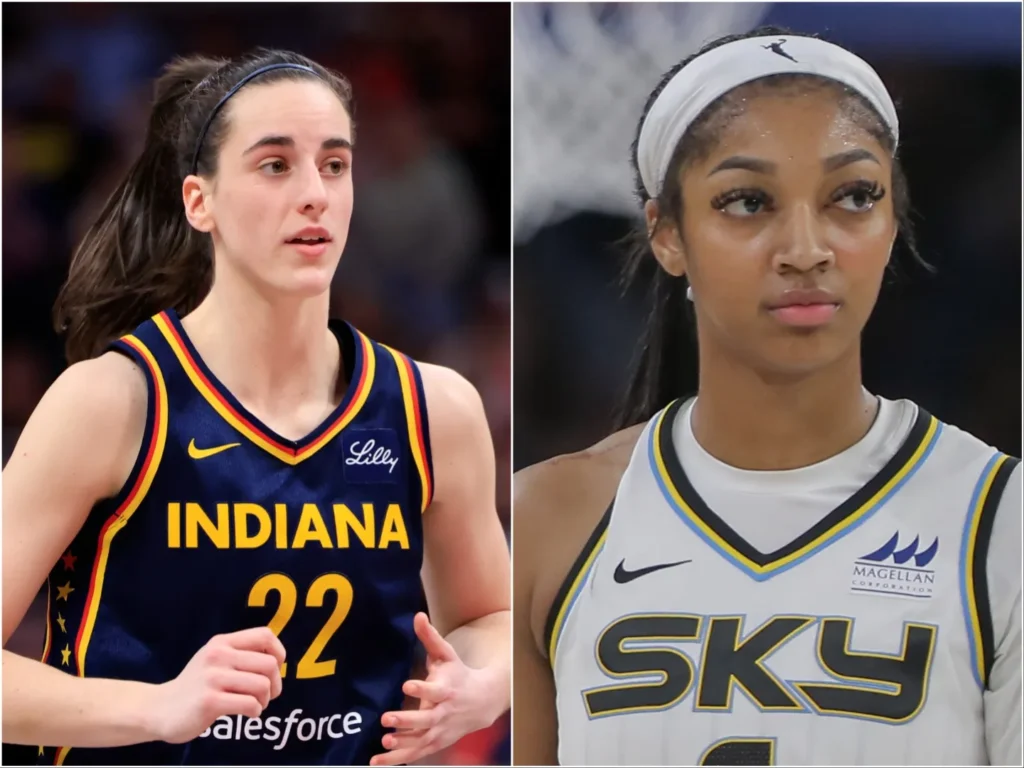
### Title: Caitlin Clark and Angel Reese: The Unwitting Faces of a Media-Fueled Race War
In a world where sports are often seen as a unifying force, bringing together people of different backgrounds in the shared joy of competition, the narrative surrounding two young basketball stars, Caitlin Clark and Angel Reese, has taken a deeply divisive turn. The media’s portrayal of these athletes has ignited a contentious debate, thrusting them into the center of a so-called “race war” that is not only unfair but also detracts from their athletic achievements.
#### The Athletes: Caitlin Clark and Angel Reese
Caitlin Clark, a standout guard for the Iowa Hawkeyes, has taken the women’s college basketball scene by storm with her remarkable scoring ability, court vision, and leadership. Known for her long-range shooting and fierce competitiveness, Clark has been a beacon of excellence and a role model for many young athletes.
On the other hand, Angel Reese, a forward for the LSU Tigers, has made headlines with her dominant presence in the paint, rebounding prowess, and defensive skills. Reese, too, has become a symbol of hard work and determination, inspiring countless fans with her dedication to the game.
Both players, despite their different playing styles and positions, share a common trait: they are among the best in women’s college basketball. However, their on-court rivalry and contrasting personas have been manipulated by the media, turning what should be a celebration of their talents into a racially charged controversy.
#### The Media Narrative: A Tale of Two Athletes
The narrative began to take shape during the 2023 NCAA Women’s Basketball Tournament, where both Clark and Reese played pivotal roles in their teams’ successes. Clark’s Iowa team and Reese’s LSU squad were both strong contenders, and their paths were set to cross in a high-stakes matchup.
The media coverage of Clark and Reese, however, took markedly different tones. Clark, who is white, was often depicted as a gritty, hardworking, and humble athlete. Headlines celebrated her as the “face of women’s basketball,” praising her for revitalizing interest in the sport with her spectacular performances.
In contrast, Reese, who is Black, was frequently portrayed through a different lens. Despite her undeniable talent and impact on the court, some media outlets focused on her assertiveness and competitive nature, framing her actions in a less favorable light. This dichotomy in coverage sparked outrage among fans and commentators who saw it as a clear example of racial bias.
#### The Incident: A Flashpoint for Controversy
The tension reached a boiling point during a heated moment in the tournament. After a particularly intense game, Reese made a gesture towards Clark, mimicking the “you can’t see me” taunt popularized by professional wrestler John Cena. This action, which would typically be viewed as part of the competitive spirit of the game, was seized upon by the media and social media users alike.
Critics quickly labeled Reese’s gesture as unsportsmanlike and disrespectful, while others defended it as a justified response in the heat of competition. The disparity in the reactions further highlighted the underlying racial dynamics at play. When Clark had made a similar gesture in a previous game, it was largely dismissed as harmless showmanship. The different receptions to similar actions by the two athletes underscored the racial double standards that persist in sports media.
#### The Broader Context: Race and Sports
The controversy surrounding Clark and Reese is not an isolated incident but rather a reflection of broader societal issues. Race has long been a contentious topic in sports, influencing how athletes are perceived and portrayed. Black athletes, in particular, often face stereotypes that affect how their actions are interpreted. They are frequently depicted as more aggressive, while their white counterparts are more likely to be described as strategic or passionate.
This double standard extends beyond individual athletes to the representation of entire teams and sports. Historically, predominantly Black sports like basketball and football have been scrutinized differently compared to predominantly white sports such as swimming or gymnastics. The media’s role in perpetuating these stereotypes cannot be overlooked, as it shapes public perception and reinforces existing biases.
#### The Impact on Clark and Reese
For Caitlin Clark and Angel Reese, the media firestorm has been both a distraction and a source of frustration. Both athletes have expressed a desire to be recognized for their skills and contributions to the game rather than being reduced to symbols in a larger cultural battle.
Clark, in interviews, has emphasized her respect for Reese and her desire for the focus to be on their shared love of basketball. She has spoken out against the unfair treatment of Reese, calling for more balanced and respectful coverage of all athletes regardless of race.
Reese, too, has voiced her disappointment with how the media has handled the situation. She has highlighted the resilience required to navigate the additional pressures placed on Black athletes and called for a change in how athletes are portrayed.
#### Moving Forward: A Call for Change
The situation with Clark and Reese has sparked important conversations about race, media representation, and fairness in sports. It has exposed the deep-seated biases that still exist and the need for a more equitable approach to sports journalism.
Firstly, media organizations must take responsibility for their role in perpetuating racial stereotypes. This involves not only changing how stories are framed but also ensuring diversity within their own ranks. A more diverse newsroom can bring different perspectives and help avoid one-dimensional portrayals of athletes.
Secondly, fans and commentators should be mindful of their reactions and the language they use. Recognizing and challenging our own biases is a crucial step towards a more inclusive sports culture.
Finally, athletes like Clark and Reese should continue to be vocal advocates for change. Their platforms give them a unique opportunity to influence public discourse and push for a fairer representation of all athletes.
### Conclusion
Caitlin Clark and Angel Reese are two exceptional basketball players who have found themselves at the center of an unfair and unnecessary race war. The media’s portrayal of these athletes highlights the racial biases that persist in sports journalism and society at large. As fans, commentators, and media professionals, we have a responsibility to celebrate their achievements without reducing them to mere symbols in a larger cultural battle. By striving for more balanced and respectful coverage, we can ensure that the focus remains where it belongs: on the talent, dedication, and love of the game that Clark and Reese embody.





